We’ve all been there – that familiar throbbing in your head signaling a headache. For humans, mild headaches are a common nuisance, easily relieved with rest or over-the-counter pain medication. But have you ever wondered if our feline companions experience the same discomfort? The question “Do Cats Get Headaches?” is one that puzzles many cat owners. While we can’t definitively ask a cat if they have a headache in the same way we can ask a person, understanding the potential for feline head pain and how to recognize it is crucial for responsible cat ownership.
Although proving that cats experience fleeting, harmless headaches like humans (known as primary headaches) is impossible, there’s substantial evidence suggesting they can suffer from secondary headaches. These are headaches caused by underlying health issues, and they can indeed cause significant pain in our feline friends. Let’s explore the possibilities of feline headaches, what might cause them, and how you can recognize if your cat is experiencing head pain.
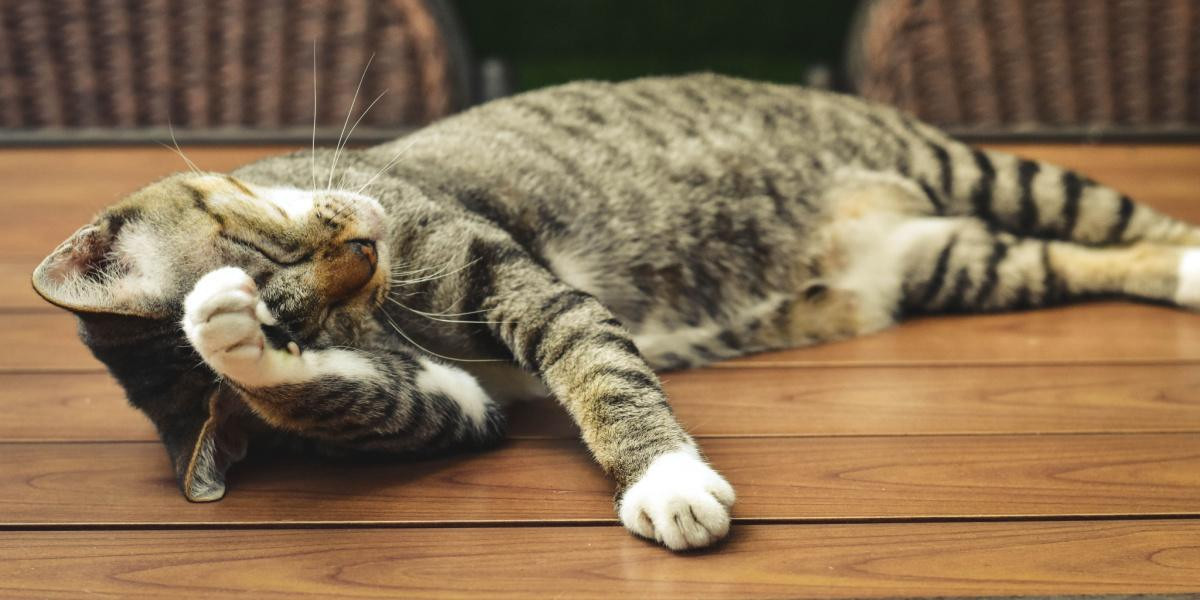 A comical picture of a cat with a humorous expression, seemingly experiencing a headache or discomfort.
A comical picture of a cat with a humorous expression, seemingly experiencing a headache or discomfort.
Recognizing Pain in Cats: Decoding Subtle Signs
Cats are masters at masking pain. This evolutionary trait, developed to protect them from predators in the wild, means that recognizing when your cat is uncomfortable can be challenging. They often don’t vocalize their pain overtly, and their subtle cues can be easily missed if you’re not paying close attention. Understanding feline pain signals is the first step in helping your cat if they are experiencing a headache or any other kind of discomfort.
While a direct complaint about a headache is impossible, several behavioral changes can indicate that your cat is in pain, potentially head pain. According to the Glasgow Composite Measure Pain Scale, a validated tool used by veterinarians to assess pain in cats, these signs can include:
- Excessive Vocalization: While cats communicate through meows, sudden increases in vocalization, including frequent meowing, crying, growling, or groaning, can be a sign of pain. This is especially true if the vocalization is out of character for your cat.
- Restlessness and Fidgeting: A cat in pain might exhibit increased restlessness. They may struggle to get comfortable, constantly shifting positions, or pacing more than usual.
- Licking Lips: Lip licking in cats, particularly when not related to eating or grooming, can be a subtle sign of nausea or discomfort, which can be associated with pain.
- Body Tension and Crouching: Observe your cat’s posture. A tense body, a hunched posture, or a reluctance to stretch out can indicate pain. They might appear stiff or rigid in their movements.
- Ears Angled Down and Outward: Changes in ear position can be telling. Ears held flattened downwards or rotated outwards can be a sign of discomfort or stress related to pain.
- Withdrawal and Lack of Interaction: A normally affectionate cat might become withdrawn, avoiding interaction, and not responding to petting or vocal greetings as they usually would. This social withdrawal can be a significant indicator of pain.
- Aggressive Behavior When Touched: Pain can make a cat defensive. If your cat displays aggressive behavior like biting, hissing, or scratching when you attempt to pick them up or touch them, especially around the head and neck area, it could be a sign of pain.
- Inappetence (Loss of Appetite): While many factors can affect a cat’s appetite, a sudden or persistent decrease in food intake can be linked to pain.
- Lethargy and Dullness: A general decrease in activity levels, lack of energy, and a dull or listless demeanor can signal that your cat isn’t feeling well and could be in pain.
- Open Mouth Breathing (Panting) or Shallow, Rapid Breathing: While less common in cats than in dogs, panting, or rapid, shallow breaths can be a sign of significant pain or distress.
 A cute cat with its eyes closed, appearing serene and content while resting.
A cute cat with its eyes closed, appearing serene and content while resting.
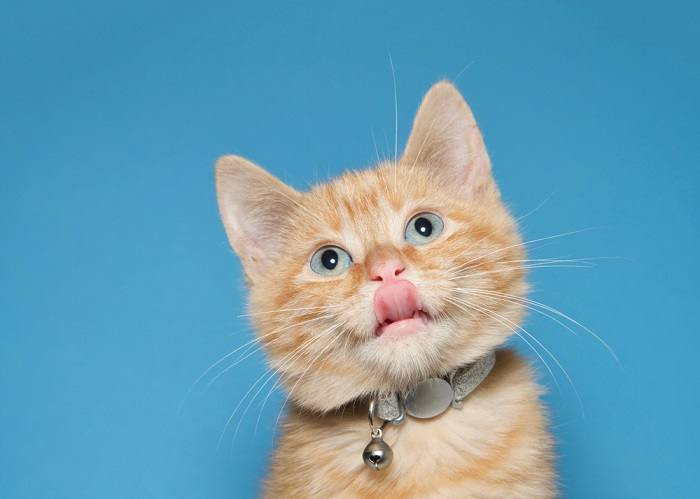 A cat captured mid-lick, with its tongue delicately brushing across its lips, showcasing feline grooming behavior.
A cat captured mid-lick, with its tongue delicately brushing across its lips, showcasing feline grooming behavior.
Possible Causes of Headaches in Cats: Exploring the Root Issues
If you observe these pain signs in your cat, and you suspect they might be experiencing head pain, it’s important to consider the potential underlying causes. Just like in humans, headaches in cats can stem from various factors, ranging from minor to serious. Understanding these potential causes can help you better communicate with your veterinarian and ensure your cat receives the appropriate care.
Here are some common causes of secondary headaches in cats:
1. Head Trauma: Injury to the Cranium
Head trauma is a significant cause of head pain in cats. Whether from a fall, a collision with a vehicle, or an altercation with another animal, impacts to the head can result in headaches. The severity of the headache will depend on the force of the trauma and the area affected.
While visible wounds are often present after head trauma, sometimes the signs are more subtle. Even without external injuries, head trauma can cause internal issues leading to headaches. Be alert for behavioral changes following a potential head injury, such as:
- Unusual Eye Movements: Jerky, uncontrolled eye movements or changes in pupil size can indicate neurological issues from head trauma.
- Abnormal Balance and Coordination: Stumbling, tilting the head, or a loss of coordination can be signs of head trauma affecting balance centers in the brain.
- Changes in Consciousness: Lethargy, disorientation, or even temporary loss of consciousness can occur after head trauma.
- Seizures: In severe cases, head trauma can trigger seizures.
Any suspected head trauma in cats warrants immediate veterinary attention. Even if initial signs seem mild, internal injuries can be serious and require prompt diagnosis and treatment.
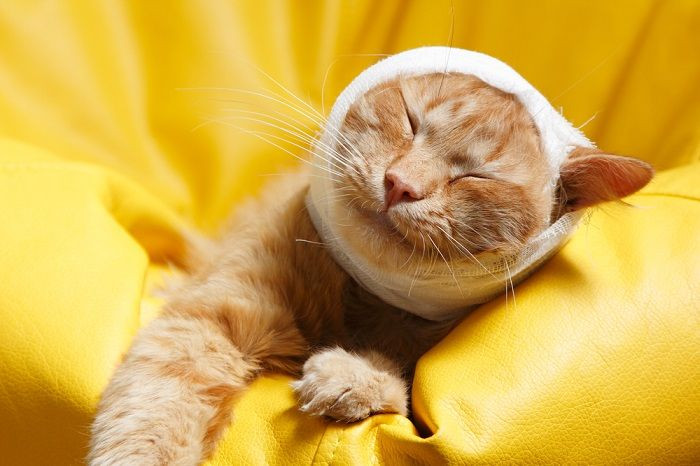 A cat wearing a head bandage, possibly recovering from an injury or surgery, showing resilience and the need for care.
A cat wearing a head bandage, possibly recovering from an injury or surgery, showing resilience and the need for care.
2. Dehydration: The Importance of Hydration
Dehydration, a common issue in cats, can also lead to headaches. Just as dehydration can cause headaches in humans, it can have the same effect on our feline companions. When the body lacks sufficient fluids, it can impact various bodily functions, including potentially causing head pain.
Ensuring your cat stays properly hydrated is crucial for their overall health and may help prevent dehydration-related headaches. Consider these tips to encourage your cat to drink more water:
- Fresh Water Availability: Always provide multiple sources of fresh, clean water around your home.
- Water Bowl Preferences: Some cats are particular about their water bowls. Experiment with different materials (ceramic, glass, stainless steel) and sizes to find what your cat prefers.
- Water Freshness: Change your cat’s water at least daily to keep it appealing. Stale water is less enticing to drink.
- Location of Water Bowls: Avoid placing water bowls too close to food bowls or litter boxes, as cats prefer their water sources to be separate.
- Running Water: Many cats are attracted to moving water. Consider a cat water fountain to encourage drinking.
- Wet Food Diet: Supplementing your cat’s diet with wet food can significantly increase their daily fluid intake.
- Monitor for Overheating: On hot days, ensure your cat has access to cool, shaded areas and plenty of fresh water to prevent heat exhaustion and dehydration.
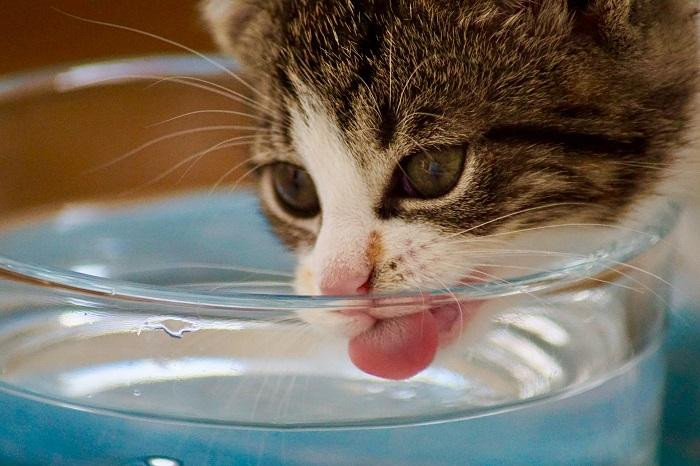 A cute kitten quenching its thirst by delicately drinking water, captured in a refreshing moment.
A cute kitten quenching its thirst by delicately drinking water, captured in a refreshing moment.
3. Tumors: Brain and Head Growths
While a scary prospect for any cat owner, brain tumors and tumors in the head region can be a cause of persistent headaches in cats. These growths can put pressure on the brain and surrounding structures, leading to pain. Tumors may also cause other neurological symptoms in addition to headaches, such as:
- Seizures: Brain tumors can disrupt normal brain activity, leading to seizures.
- Imbalance and Incoordination: Tumors affecting the brain’s balance centers can cause loss of coordination and balance issues.
- Blindness or Vision Changes: Tumors pressing on the optic nerves or affecting vision centers in the brain can lead to vision problems.
- Head Tilting: A persistent head tilt can be a sign of a tumor affecting the brain or vestibular system.
If you suspect your cat is experiencing persistent head pain, especially if accompanied by any of these neurological signs, a veterinary examination is crucial. Diagnostic imaging, such as X-rays or more advanced scans like CT or MRI, might be necessary to investigate the possibility of tumors.
 An unfortunate image of a cat with a visible tumor, highlighting the importance of veterinary care and early detection for pets.
An unfortunate image of a cat with a visible tumor, highlighting the importance of veterinary care and early detection for pets.
4. Dental Pain: Often Overlooked Source of Headaches
Dental pain is a surprisingly common, yet often underestimated, cause of headaches in cats. Dental issues, such as periodontal disease, tooth abscesses, or broken teeth, can cause significant pain that can radiate to the head, resulting in headaches.
Cats are adept at hiding dental pain. Many cat owners mistakenly believe that a cat with dental problems will stop eating. However, cats often continue to eat normally despite experiencing considerable dental discomfort. This makes it crucial to be proactive about your cat’s dental health.
Regular veterinary dental checkups are essential, ideally annually. If you notice any signs of dental problems, such as bad breath, drooling, difficulty chewing, or pawing at the face, schedule a veterinary appointment promptly.
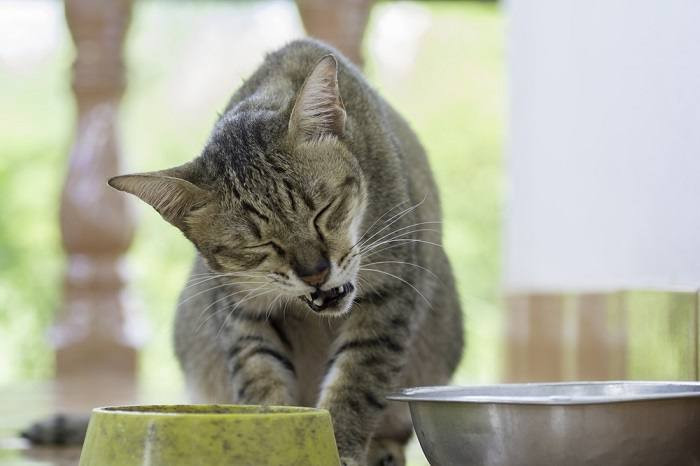 A cat experiencing dental pain, emphasizing the significance of dental health care for pets.
A cat experiencing dental pain, emphasizing the significance of dental health care for pets.
5. Sinusitis: Inflammation of the Sinuses
Sinusitis, or inflammation of the sinuses, can also cause headaches in cats, much like in humans. Upper respiratory infections, commonly known as cat colds, can lead to sinusitis. The inflammation and pressure within the sinuses can result in head pain.
Allergies can also trigger sinusitis in cats. Common feline allergens include dust mites, pollen, mold, and even household products like air fresheners. Besides headaches, sinusitis in cats may also present with symptoms like:
- Nasal Congestion: A stuffy or runny nose.
- Sneezing: Frequent sneezing as the cat tries to clear their nasal passages.
- Discharge from the Nose or Eyes: Discharge can be clear, yellow, or green, depending on the cause of sinusitis.
If you suspect your cat has sinusitis, veterinary care is recommended to diagnose the underlying cause and provide appropriate treatment, which may include antibiotics for bacterial infections or allergy management.
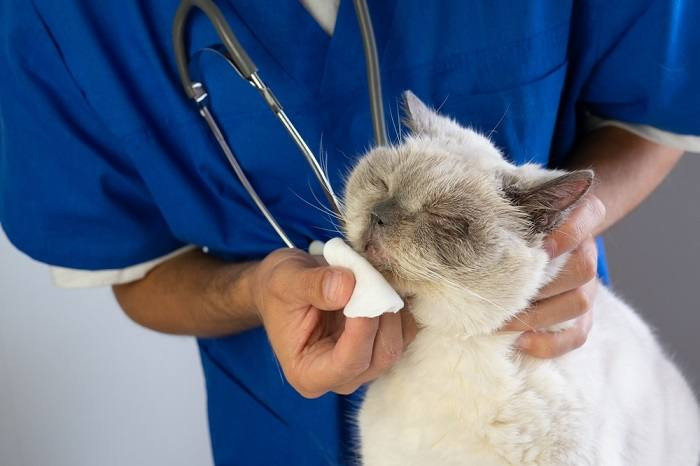 A cat showing signs of sinusitis, a condition that can affect their respiratory health, underlining the importance of prompt veterinary attention and treatment.
A cat showing signs of sinusitis, a condition that can affect their respiratory health, underlining the importance of prompt veterinary attention and treatment.
What To Do If You Think Your Cat Is in Pain: Seeking Veterinary Guidance
If you are concerned that your cat might be experiencing headaches or showing signs of pain, the most important step is to consult with your veterinarian. Your vet is best equipped to assess your cat’s symptoms, determine the underlying cause of their discomfort, and recommend the appropriate course of action.
Don’t hesitate to reach out to your veterinary clinic if you have concerns. Depending on the symptoms you describe, they may offer advice over the phone or recommend bringing your cat in for a physical examination. A thorough veterinary examination and potentially diagnostic tests are crucial for accurately diagnosing the cause of your cat’s pain and ensuring they receive the necessary treatment and relief.
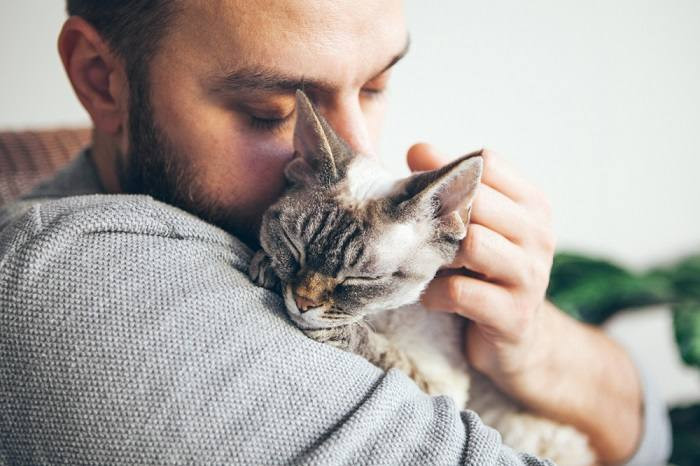 A distressed cat in pain, highlighting the need for compassionate care and medical attention for feline companions experiencing discomfort or distress.
A distressed cat in pain, highlighting the need for compassionate care and medical attention for feline companions experiencing discomfort or distress.
In Summary: Being Proactive About Your Cat’s Health
While we cannot definitively know if cats experience primary headaches like humans, it’s clear that cats can suffer from secondary headaches caused by various underlying health issues. Recognizing the subtle signs of pain in cats is paramount for responsible pet ownership. By being observant, understanding the potential causes of feline head pain, and seeking timely veterinary care when you suspect your cat is uncomfortable, you can play a vital role in ensuring their well-being. Early diagnosis and treatment are key to managing any underlying conditions causing headaches and improving your cat’s quality of life.
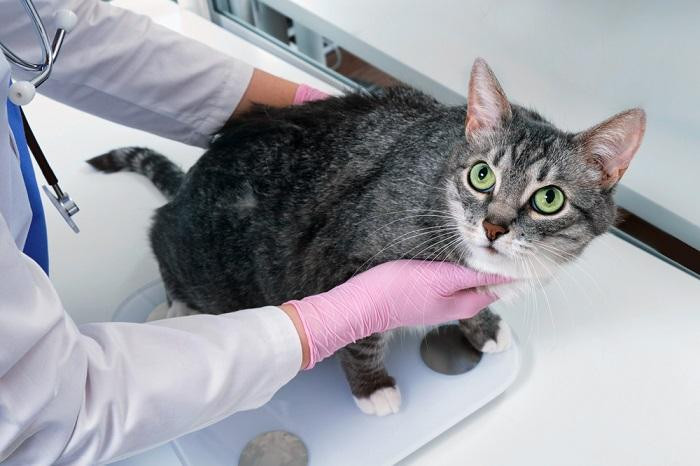 A cat undergoing a veterinary check-up, emphasizing the importance of regular health examinations to ensure the well-being of our feline friends.
A cat undergoing a veterinary check-up, emphasizing the importance of regular health examinations to ensure the well-being of our feline friends.
Frequently Asked Questions
Can you tell if a cat is in pain?
Yes, although cats are skilled at hiding pain. Look for subtle behavioral changes such as excessive vocalization, aggressive behavior, body tension, and withdrawal as potential indicators of pain.
Do animals suffer from headaches?
Yes, animals, including cats, can suffer from headaches, although the specific causes may vary depending on the species and underlying health conditions. If you are worried your pet might have a headache, consult with your veterinarian.
Why do cats press their head against the wall?
Head pressing, where a cat presses their head against a wall or other object, can be a sign of a neurological issue. This behavior warrants immediate veterinary attention as it can indicate serious underlying conditions affecting the brain.

